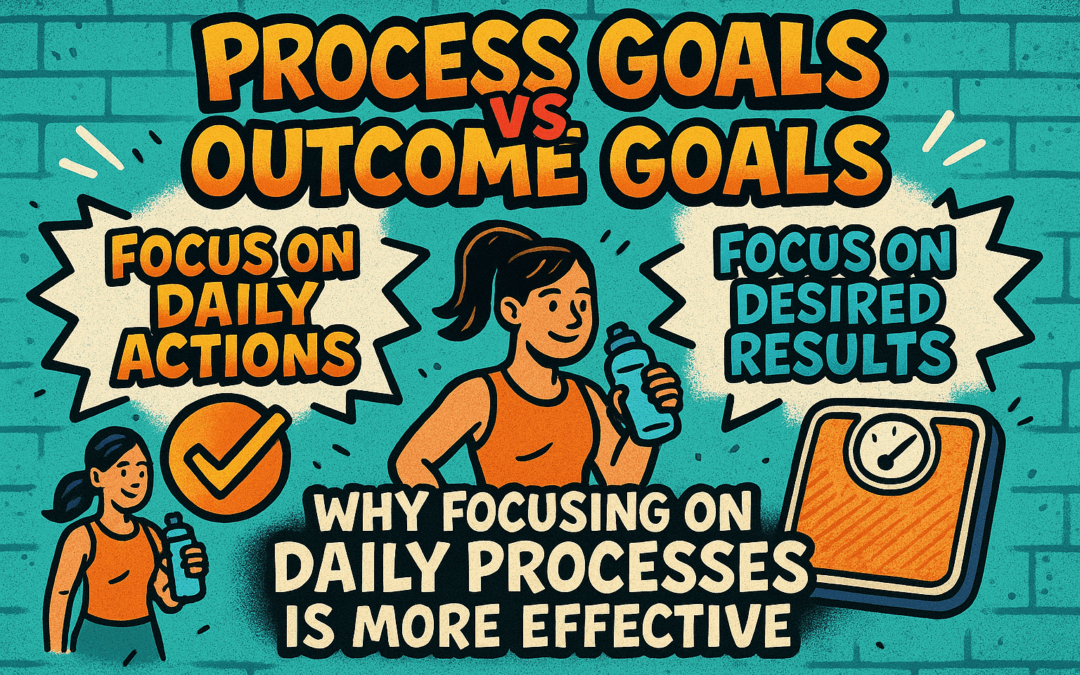Process Goals vs. Outcome Goals: Why Focusing on the Daily Work Wins
When it comes to losing weight or getting healthier, most people start with outcome goals:
-
“I want to lose 20 pounds.”
-
“I want to run a 5K.”
-
“I want to fit into these jeans.”
There’s nothing wrong with having a vision of where you want to go, but here’s the catch: outcome goals are out of your direct control. You can’t make the scale say “20 pounds lighter” on a specific date. You can’t guarantee how your body will adapt in a certain timeframe. And when progress slows down (which it always does), outcome goals often lead to frustration, discouragement, and giving up.
That’s where process goals change the game.
What Are Process Goals?
Process goals are the daily actions and habits that move you toward your outcomes. They’re the things you can control today, tomorrow, and the next day:
-
Drinking 80 ounces of water daily
-
Hitting 120 grams of protein
-
Strength training three days per week
-
Walking 8,000 steps
-
Going to bed by 10:30 p.m.
Unlike outcome goals, process goals are completely within your control. If you do them consistently, results happen as a byproduct.
Why Process Goals Work Better
-
Consistency Beats Intensity
A single perfect workout won’t change your body. But showing up three times per week for six months? That’s transformation. -
They Reduce Frustration
You can’t force the scale to move every week. But you can check the box that you got your protein, trained, and hydrated. Wins stack up daily, not just when the number changes. -
They Build Momentum
Success breeds success. Nailing your process goals gives you small wins that build motivation, instead of waiting for some far-off “finish line.” -
They Create Identity Change
You stop thinking, “I’m trying to lose weight” and start thinking, “I’m the kind of person who eats protein with every meal, trains regularly, and takes care of myself.” That identity shift sticks long after the outcome is reached.
An Example
Two people set out to lose 20 pounds:
-
Person A (Outcome Focused):
Steps on the scale every morning, obsessed with the number. Skips workouts if the scale doesn’t move. Cuts calories too hard, then burns out. -
Person B (Process Focused):
Doesn’t stress over the scale. Tracks daily protein, workouts, and steps. Celebrates hitting those goals each week. Weight drops slower, but steadily …and six months later, they’re not only lighter, but healthier and more consistent.
Guess who actually keeps the weight off?
How to Shift from Outcomes to Processes
-
Write down your big outcome goal (like “lose 20 pounds”).
-
Break it into 3–5 daily or weekly process goals.
-
Track your process—not just your progress. Did you hit your protein goal? Did you train? Did you walk?
-
Let the outcome take care of itself.
Final Thought
Outcome goals give you direction, but process goals keep you moving. If you focus on the actions you can control every day, the results take care of themselves.
Consistency is the real secret to getting healthier.
“If you’re ready to build the kind of daily habits that actually stick, grab a copy of The Fitness Blueprint and learn how to create a process-driven plan that works for you.”

